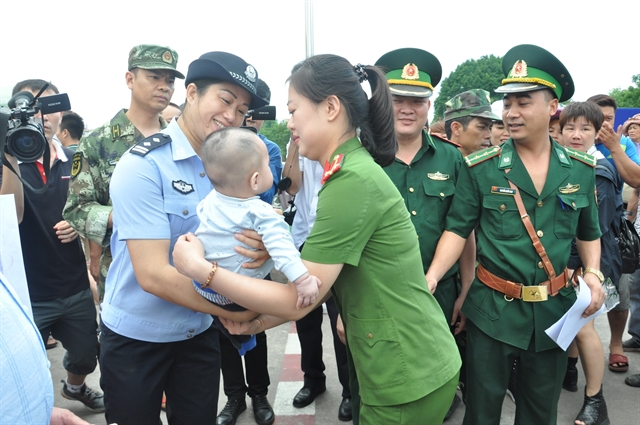 Society
Society

A report carried out into people trafficking in Việt Nam has shed new light on the criminals responsible.

|
| Quảng Ninh Province Police receive a Vietnamese baby from Chinese Police after he was rescued from human traffickers in China in May 2018. VNA/VNS Photo Nguyễn Hoàng |
Paul Kennedy & Vũ Thu Hà
A report carried out into people trafficking in Việt Nam has shed new light on the criminals responsible.
Although many people perceive people traffickers to be ‘fat cat’ gangsters living luxurious lifestyles, driving fast cars, and enjoying the trappings of their ill-gotten gains, the study by Blue Dragon Children’s Foundation paints a far different picture.
They have found the average people trafficker is from a similar economically-challenged background as the people they are trafficking.
Many are ill-educated and in desperate need so turn to trafficking in a last-ditch attempt to make money.
And although if caught they face the prospect of heavy punishments with the highest sentence being the death penalty, the report found in many cases, smugglers receive just $1,500 payment for trafficking an individual.
“Many of those convicted traffickers are uneducated,” said Lê Thị Hồng Lương of Blue Dragon, co-author of the report.
“More than 90 per cent are illiterate, have not finished high school, or do not have a stable job. A lot of people are unemployed, living in villages, which means they have the same background as the victims.
“This means that both victims and traffickers are vulnerable to human trafficking, but they choose different paths.”
Blue Dragon Children’s Foundation finds children and young people in crisis situations such as slavery, homelessness, and extreme poverty.
As well as rescuing the youngsters, they also work with them long-term to overcome their trauma and try and lead a better life.
Blue Dragon’s Caitlin Wyndham, who also wrote the report, added: “The traffickers are really just as desperate as their victims.
“They generally have poor educational background and maybe don’t really understand that selling someone else is illegal.
“They may think they are helping someone to find a legitimate job in China, and the average amount that a trafficker was paid is around US$1,500.”
In many cases, the report found that the traffickers were from the same villages as the people they were trafficking.
And in some instances, they not only knew their victims but were related to them.
The study found that 33.67 per cent of traffickers met their victims using their smartphones or through social media. The same percentage of victims were enticed with false promises of a better life by either a friend, classmate, neighbour or even their boyfriends.
Twenty per cent of traffickers were from the same location as their victims, and a little over 5 per cent were trafficked by their own family members.
Lương said: “There have been many misunderstandings about human trafficking. In Việt Nam, it is very common for parents to tell their children not to follow strangers or accept things from strangers because they will be drugged, kidnapped, and taken to China. So is this correct? Through this report, we see that this is absolutely not the case.
“There have been no recorded cases of victims being drugged. In most cases, traffickers and victims know each other, either living in the same village, commune or hamlet, or even are friends and lovers.”
The study discovered that the majority of victims (71 per cent) were forced into marriage or domestic servitude while others were made to work in the sex industry (24 per cent).
Caitlin added: “It is really clear that improving economic opportunities and access to services will target both sides of the trafficking equation.
“It will help victims be less vulnerable and not have to leave their homes for work. It will also mean if traffickers have other economic opportunities maybe they won’t sell their neighbours.”
The report found that a very high number of ethnic minority girls were targeted by traffickers, with many lulled into a false sense of security believing they were starting a relationship with an ‘online boyfriend’.
To combat this, the study suggested the greater need not only for online safety, but also for education to prevent early marriage among this demographic.
It also concluded the importance of teaching correct skills so people can critically examine potential job offers and online relationships to reduce the risk of exploitation.
“We know a lot about victims, but we don’t know so much about the traffickers,” Caitlin said.
“In order to effectively prevent trafficking, we knew we needed to know more about the traffickers and the trafficking crime so we could do better prevention efforts.
“This report is really valuable for us because it means we can really target our prevention activities. The best way to stop trafficking is to prevent it from happening in the first place.
“We would love to be in a position where we don’t have to rescue any victims at all, because there are no victims.
“So what this report tells us is that we can target the same communities but with messages that help victims understand the risks as well as educating communities on the fact that trafficking is illegal and that you may get caught and if you do get caught, there are very strict sentences.” VNS
Related stories:




